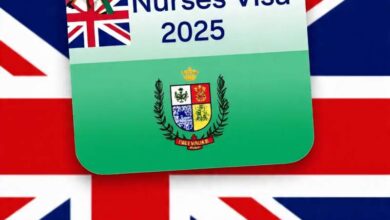US Green Card Sponsorship for Registered Nurses 2026: Complete Guide

When I first dreamed of advancing my nursing career in the United States, I quickly realized that securing a work visa was only part of the journey. The real key to long-term stability and career growth was obtaining a green card.

Like many nurses around the world, I had questions: How do I qualify? Which employers offer sponsorship? How long will the process take? If you’ve ever asked these questions, you’re not alone—and that’s exactly why this guide exists.
In this comprehensive article, we’ll explore US Green Card Sponsorship for Registered Nurses 2026, breaking down everything you need to know to make your American nursing career a reality. From understanding the types of green cards available for nurses, eligibility requirements, and employer sponsorship options, to the step-by-step application process, this guide provides practical, actionable advice. Whether you’re an experienced RN seeking a new opportunity in the U.S. healthcare system or a recent graduate planning your future, every crucial detail is covered in plain, clear language.
By the end of this guide, you’ll not only understand how US Green Card Sponsorship for Registered Nurses 2026 works but also gain insights into strategies that can speed up approvals and avoid common pitfalls. With careful planning, the right documentation, and a clear roadmap, you can confidently navigate the green card process and take your nursing career to the next level in the United States.
Verified : What is the Visa fees and processing time for Nigerian nurses moving to Canada 2025
Eligibility Criteria for US Green Card Sponsorship for Registered Nurses in 2026
Before you start the green card application process, it’s crucial to understand the eligibility requirements. Not all nurses qualify automatically, and meeting these criteria can significantly improve your chances of approval.
1. Valid Nursing License
You must hold an active nursing license in your home country or U.S. state if already practicing in the United States. For foreign-educated nurses, credentials must be evaluated and recognized through a body like CGFNS (Commission on Graduates of Foreign Nursing Schools).
2. Job Offer from a U.S. Employer
A permanent, full-time job offer from a U.S. healthcare employer is required. Your employer must be willing and eligible to sponsor your green card, typically under the EB-3 (Skilled Worker) category for nurses.
3. Passing the NCLEX-RN
Foreign-trained nurses must pass the NCLEX-RN exam to obtain licensure in the United States. This is a mandatory step before filing a green card petition.
4. English Language Proficiency
Demonstrating proficiency in English is required, usually through recognized tests such as IELTS or TOEFL, unless you are from an English-speaking country.
5. Credential Evaluation and Experience
-
A recognized evaluation of your nursing degree and qualifications
-
Some employers may require a minimum amount of clinical experience, often 1–2 years, especially for foreign-trained nurses
6. Ability to Meet Immigration Requirements
You must be admissible to the United States, meaning no significant criminal record, health issues that prevent you from working, or prior immigration violations.
Understanding these criteria is the first step in successfully navigating US Green Card Sponsorship for Registered Nurses 2026. In the next section, we’ll break down the types of green cards available for nurses and which option might suit you best.
Types of US Green Cards for Registered Nurses in 2026
When it comes to securing permanent residency in the United States, registered nurses have a few main pathways through employer sponsorship.

Understanding each option helps you choose the most suitable route for your career goals.
1. EB-3 Green Card (Skilled Worker Category)
The EB-3 visa is the most common pathway for nurses. It allows foreign-trained nurses with a valid job offer from a U.S. employer to obtain permanent residency. Key points include:
-
Requires a full-time, permanent job offer from a U.S. hospital or healthcare facility
-
Labor Certification (PERM) from the Department of Labor to confirm no qualified U.S. worker is available for the position
-
Eligibility for both foreign-educated and U.S.-educated nurses
2. EB-2 Green Card (Advanced Degree or Exceptional Ability)
While less common for standard RN roles, the EB-2 category is an option for nurses with advanced degrees (e.g., MSN) or exceptional ability in nursing practice. This route can be faster than EB-3 if you meet the criteria.
3. National Interest Waiver (NIW)
For highly specialized nurses in critical shortage areas, a National Interest Waiver may allow bypassing employer sponsorship requirements. Approval requires demonstrating that your work benefits the U.S. healthcare system significantly.
4. Temporary Work-to-Permanent Options
Some nurses first enter the U.S. on temporary work visas (like H-1B or TN, depending on eligibility) and later transition to a green card via EB-3. This is a common strategy for foreign-trained nurses awaiting labor certification and green card processing.
Choosing the right green card pathway depends on your education, experience, and the type of U.S. employer sponsoring you. In the next section, we’ll provide a step-by-step guide on how to apply for US Green Card Sponsorship for Registered Nurses in 2026, including timelines, documentation, and key tips.
Best Scholarships for African Nurses to Study Abroad (USA, UK, Canada) in 2025
Step-by-Step Guide to Apply for US Green Card Sponsorship for Registered Nurses in 2026
Securing a green card as a registered nurse requires a structured approach. Following these steps carefully can help you navigate the process smoothly and avoid common mistakes.
Step 1: Secure a Job Offer from a U.S. Employer
-
Apply to hospitals, clinics, or healthcare organizations approved to sponsor nurses.
-
Ensure the employer is willing to initiate green card sponsorship under the EB-3 (Skilled Worker) category.
Step 2: Credential Evaluation
-
Foreign-educated nurses must have their credentials evaluated by CGFNS or another recognized authority.
-
This confirms that your nursing degree and training meet U.S. standards.
Step 3: Pass the NCLEX-RN Exam
-
Register for and pass the NCLEX-RN to obtain licensure in the U.S.
-
This is a mandatory step for all foreign-trained nurses seeking permanent residency.
Step 4: Labor Certification (PERM)
-
Your employer files for PERM Labor Certification with the Department of Labor.
-
This process verifies that no qualified U.S. worker is available for your nursing position.
Step 5: File Form I-140 (Immigrant Petition)
-
Once PERM is approved, your employer submits Form I-140 to USCIS.
-
This establishes your eligibility under the EB-3 or EB-2 category for permanent residency.
Step 6: Wait for Priority Date and Visa Availability
-
Your priority date must be current according to the Visa Bulletin.
-
Processing times vary based on your country of origin.
Step 7: File Form I-485 (Adjustment of Status) or Consular Processing
-
If already in the U.S., file Form I-485 to adjust status to permanent resident.
-
If outside the U.S., complete consular processing at the U.S. embassy in your country.
Step 8: Attend Interview and Receive Green Card
-
Attend a USCIS or consulate interview if required.
-
Upon approval, receive your green card and start your permanent residency journey in the U.S.
Following this structured process ensures you meet all requirements and can navigate US Green Card Sponsorship for Registered Nurses 2026 efficiently.
Essential Documents and Preparation Tips for Nurses Applying for a US Green Card in 2026
Proper preparation and organization can make the green card process smoother and significantly reduce delays.

Below are the critical documents and practical tips to help you stay on track.
Essential Documents
-
Personal Identification
-
Valid passport with at least six months of remaining validity
-
Birth certificate and other identity documents as required
-
Passport-sized photographs meeting USCIS specifications
-
Educational and Professional Credentials
-
Nursing diploma or degree certificates
-
Transcripts from nursing school
-
Credential evaluation report from CGFNS or equivalent body
-
Professional nursing license from your home country
-
Work Experience Documentation
-
Letters of recommendation from previous employers
-
Employment verification letters stating job title, duties, and dates of employment
-
Licensing and Exam Proof
-
NCLEX-RN exam results
-
State nursing license in the U.S. (if already licensed)
-
Visa and Immigration Forms
-
Job offer letter from a U.S. employer willing to sponsor
-
Labor Certification (PERM) approval notice
-
Form I-140 and I-485 (if applying within the U.S.) or consular processing documents
-
English Language Proof
-
IELTS or TOEFL results if required
Preparation Tips
-
Start Early: Credential evaluation, exam preparation, and PERM processing can take months, so begin well in advance.
-
Stay Organized: Keep both digital and physical copies of all documents. Use a checklist to track deadlines.
-
Double-Check Everything: Minor errors can delay processing or lead to denial.
-
Maintain Open Communication: Stay in touch with your employer and immigration authorities for updates or additional requirements.
-
Prepare for Interviews: Practice responses about your experience, job role, and intentions to work in the U.S.
By gathering these documents in advance and following these preparation tips, you improve your chances of a smooth and timely approval for US Green Card Sponsorship for Registered Nurses 2026.
Complete guide: How to Apply for a Work Visa as a Nurse in 2026 (USA, UK, Canada)
Common Mistakes to Avoid When Applying for a US Green Card as a Nurse
Even small errors can cause delays or denials in the green card process. Being aware of these pitfalls helps you avoid unnecessary setbacks and ensures a smoother application experience.
1. Incomplete or Incorrect Documentation
Submitting missing or mismatched documents is one of the most common reasons for delays. Ensure your transcripts, credential evaluations, work experience letters, and identification documents are complete and consistent.
2. Ignoring Licensing or Exam Requirements
Passing the NCLEX-RN is mandatory for foreign-trained nurses. Attempting to file your green card without completing licensing or failing to meet U.S. state requirements can result in rejection.
3. Applying Too Late
The green card process, especially the EB-3 category, involves multiple steps, including PERM and visa bulletin waiting periods. Starting late can add months or even years to your timeline.
4. Using Outdated Forms
Immigration authorities frequently update forms and requirements. Always download the latest versions from official USCIS or embassy websites. Using outdated forms can cause delays or denial.
5. Failing to Meet English Proficiency Requirements
Many nurses overlook or underestimate the need for English language proof (IELTS or TOEFL). Ensure your scores meet U.S. standards and are still valid at the time of submission.
6. Overlooking Employer Responsibilities
Your sponsoring employer must be eligible and willing to support your green card petition. Miscommunication or misunderstanding their role can create avoidable issues in your application.
By avoiding these common mistakes, you significantly increase your chances of a timely and successful approval. In the next section, we’ll cover tips and strategies to speed up your green card approval and enhance your chances of success, which can make a real difference for nurses applying in 2026.
Tips and Strategies to Speed Up US Green Card Approval for Nurses
Securing a US green card as a registered nurse can be a lengthy process, but careful planning and smart strategies can help you navigate it more efficiently.

Here are key tips to increase your chances of success in 2026:
1. Start the Process Early
The green card process involves multiple steps, including credential evaluation, NCLEX-RN licensing, PERM Labor Certification, and visa petitioning. Begin preparations at least 6–12 months in advance to avoid delays.
2. Stay Organized
Keep all documents, forms, and correspondence in a well-structured system. Maintain digital and hard copies of transcripts, licenses, recommendation letters, and immigration forms.
3. Ensure Credential Accuracy
Double-check that your nursing credentials, work experience, and educational documents are evaluated correctly and meet U.S. standards. Mistakes here can cause significant delays.
4. Maintain Clear Communication with Your Employer
Your sponsoring employer plays a critical role in PERM and I-140 filings. Ensure they understand deadlines and provide all required supporting documents promptly.
5. Prepare Thoroughly for Interviews
USCIS or consular interviews can be stressful. Practice explaining your nursing experience, job responsibilities, and plans to work in the U.S. clearly and confidently.
6. Monitor Visa Bulletin Updates
The EB-3 category is subject to priority dates. Regularly check the Visa Bulletin to track when your priority date becomes current to file Form I-485 promptly.
7. Meet Language and Licensing Requirements in Advance
Ensure your NCLEX-RN exam is passed and your English proficiency test results are valid before submitting your petition. This prevents last-minute issues that can stall your application.
By applying these strategies, you can reduce delays, avoid common pitfalls, and make your journey toward US Green Card Sponsorship for Registered Nurses 2026 faster and smoother.
Best moment: My Journey from Nigeria to the UK as a Registered Nurse 2025
Quick Checklist and Roadmap for US Green Card Sponsorship for Registered Nurses in 2026
To simplify your journey toward permanent residency in the United States, follow this step-by-step roadmap and checklist:
1. Research and Choose Your Green Card Pathway
-
Decide whether EB-3, EB-2, or National Interest Waiver suits your qualifications.
-
Understand the requirements for each category and processing times.
2. Secure a Job Offer
-
Apply to U.S. hospitals or healthcare organizations licensed to sponsor nurses.
-
Confirm your employer is willing to file PERM and I-140 petitions on your behalf.
3. Credential Evaluation
-
Have your nursing degree and qualifications evaluated by CGFNS or an equivalent body.
-
Collect transcripts, diplomas, and proof of clinical experience.
4. Licensing and Exams
-
Pass the NCLEX-RN exam and obtain state licensure.
-
Complete any English language proficiency requirements (IELTS or TOEFL).
5. Labor Certification (PERM)
-
Employer files PERM Labor Certification with the U.S. Department of Labor.
-
Ensure all job requirements and documentation are accurate and complete.
6. File Immigrant Petition (Form I-140)
-
Your employer submits I-140 petition under the chosen green card category.
-
Track priority dates and wait for approval before proceeding to adjustment of status.
7. Adjustment of Status or Consular Processing
-
File Form I-485 if already in the U.S., or complete consular processing abroad.
-
Attend interviews and provide any additional requested documents.
8. Receive Green Card
-
Once approved, receive your green card and begin your permanent residency journey in the U.S.
-
Make plans for relocation, employment, and integration into the U.S. healthcare system.
9. Stay Informed and Prepared
-
Regularly monitor USCIS updates, visa bulletin changes, and licensing requirements.
-
Keep all documents organized for future employment verification or renewal purposes.
Following this roadmap ensures you remain on track and organized throughout the green card process, making US Green Card Sponsorship for Registered Nurses 2026 achievable and manageable.
Resources for US Green Card Sponsorship for Registered Nurses 2026
Official Government and Licensing Websites
-
USCIS (U.S. Citizenship and Immigration Services): https://www.uscis.gov – Official green card and immigration information.
-
CGFNS (Commission on Graduates of Foreign Nursing Schools): https://www.cgfns.org – Credential evaluations and verification for foreign-trained nurses.
-
NCLEX-RN Exam Information: https://www.ncsbn.org/nclex.htm – Official site for exam registration and resources.
English Language Proficiency Tests
-
IELTS (International English Language Testing System): https://www.ielts.org – Required for demonstrating English proficiency.
-
TOEFL (Test of English as a Foreign Language): https://www.ets.org/toefl – Alternative English proficiency test accepted by USCIS.
Job Search and Sponsorship Resources
-
American Nurses Association: https://www.nursingworld.org – Job boards, professional development, and U.S. nursing guidelines.
-
Hospital Job Boards and Recruitment Agencies: Many U.S. hospitals list openings for international nurses and provide sponsorship details.


